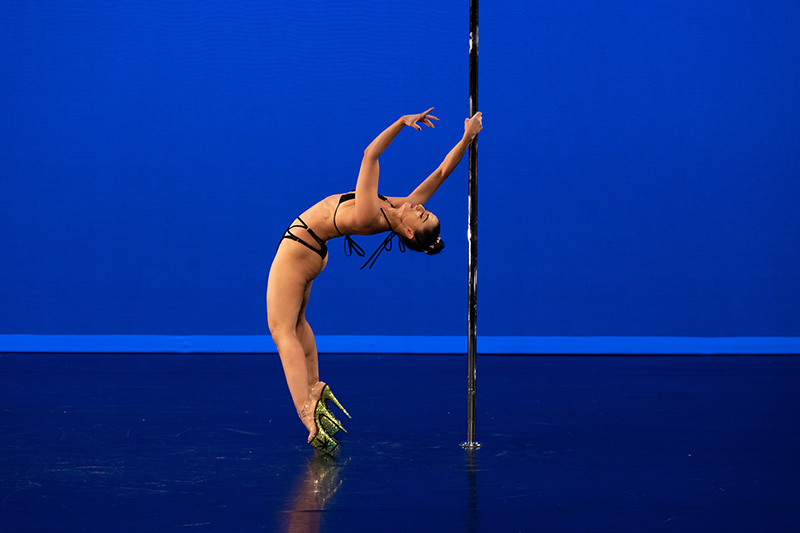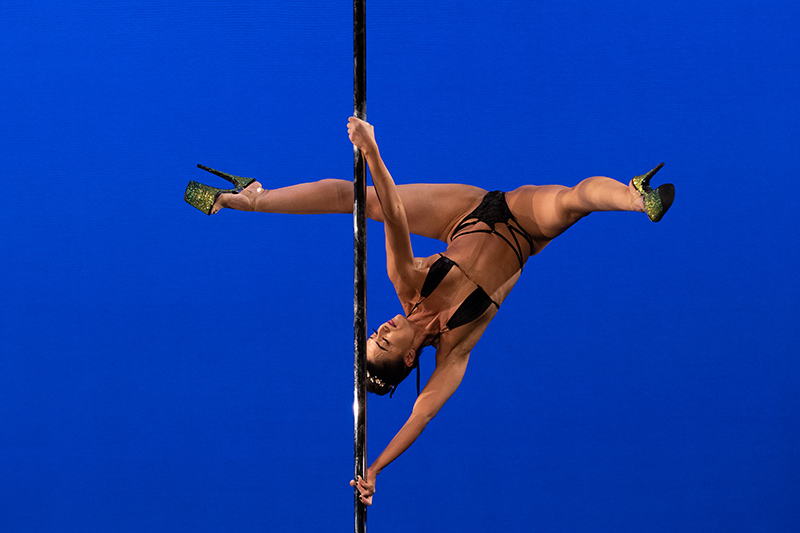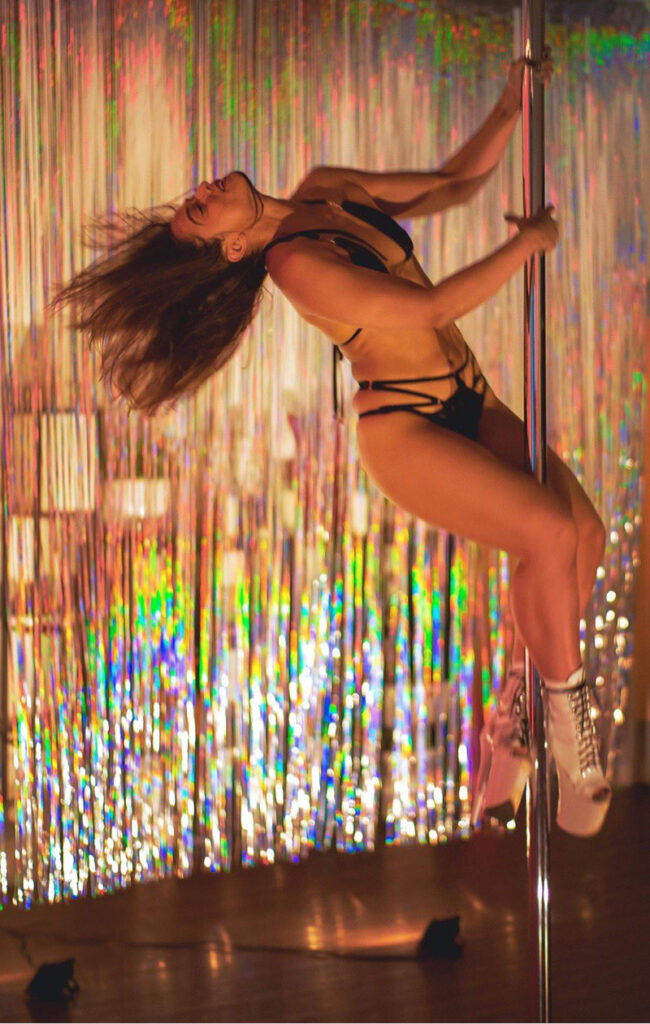Empowered by Pole Arts
BY JULIANNA MASSA
Note: This essay was first published in Stance on Dance’s fall/winter 2023 print issue. To learn more, visit stanceondance.com/print-publication.
In April of 2021, I took my first Spin Pole 101 class with Irlanda at Black Widow Pole Arts in Albuquerque, New Mexico. Six chrome poles line the floor of the studio, each one 14 feet tall, and sparkly Pleaser heels adorn the shelves. As a modern dancer, I was comforted by Irlanda’s cues to pull my belly button to the spine and imagine spreading the floor apart with my feet. When we started dancing with the pole, Irlanda’s cues suddenly became about squeezing and tension. I had to drop all my training in release technique in favor of holding onto the pole. I felt dizzy as I struggled through the next hour, fatiguing completely unfamiliar muscles. I went home and immediately purchased five more classes.
After that first class, I continued to learn at Black Widow. I’ve been lucky enough to train with Irlanda preparing for several performances at Black Widow as well as the Pole Sport Organization After Dark competition in Los Angeles in 2022. I won a silver medal in no small part due to her feedback and coaching. Irlanda’s pole dancing career spans silver and gold medal wins at Pole Sport Organization, competing in the experimental category at Haute Velour, and performing and teaching as part of the International Pole Convention’s first ever Latin showcase. Irlanda has a unique background as a dancer, choreographer, stripper, scholar, and archivist. In the summer of 2023, I interviewed Irlanda to hear her perspective on her own artistry as a dancer and the future of pole dance as a field.

Photo courtesy the artist
Irlanda first remembers dancing as a five-year-old, taking ballet classes at El Paso Community College with Ms. Lisa. When Ms. Lisa stopped teaching, Irlanda stopped taking classes, and didn’t dance again until college. At the University of Texas El Paso, Irlanda found her way back to ballet. From that point on, Irlanda wanted to dance, but like so many dancers, she did not have a clear path towards a professional dancing career while navigating money, identity, and relationships. After finishing her undergraduate degree in History and Anthropology, Irlanda earned a master’s in Library Science at the University of Arizona. As a sneaky way to keep training, she continued to take dance classes while completing her degree, writing about hip-hop and studying how countercultural movements become mainstream.
After graduate school, Irlanda moved to Albuquerque and worked as a visual resource librarian at the Bunting Visual Resource Library at University of Mexico School of Fine Arts. At the same time, she began to experience intense panic attacks. Through resources that were available to her as an employee at UNM, Irlanda began to work with a holistic therapist who encouraged her to find activities that engaged her frontal lobe. By that point, Irlanda had tried to convince herself to leave dance behind, only to find herself drawn back. As a college student, Irlanda had a stint as a stripper, where she was introduced to pole. Interested in exploring this part of her past more fully, she searched for pole dance classes. She began learning while in Albuquerque at Southwest Pole Dancing, a studio that has since closed, and immediately fell in love. Irlanda remembers feeling excited by the opportunity to once again have a movement practice that she could take seriously and approach with the kind of discipline that characterized her ballet training. Later, when she accepted a prestigious position as the university archivist at the University of Wyoming’s American Heritage Center — the first woman of color to be in that role — she purchased her own pole, transformed her kitchen into a dance studio, and often traveled back to Albuquerque to take classes.
Irlanda left academia in 2017, and in 2020, she moved back to Albuquerque to work as a stripper and to open Black Widow Pole Arts with Johanna Chong. Their decision to use the term “pole arts” instead of “pole fitness” emphasized their commitment to pole as an art form. The studio’s mission explicitly asserts the importance of sensuality and moving with purpose and intent. Today, Black Widow has a staff of 11 instructors and hosts 32 classes a week, as well as performances and guest artist workshops.
Irlanda remembers how her ballet instructor at UTEP, Andree Harper, would bluntly tell her students that maybe just one of them would become a professional dancer. Still, Harper insisted on discipline and commitment to perfecting technique from every student. She taught the foundational elements that are offered to children learning ballet for the first time to her beginning adult dance students. Similarly, at Black Widow, Irlanda welcomes beginners who may or may not have any dance or movement background, and takes them seriously as dancers and artists. As a student in her Erotic Flow classes, I’ve learned to balance on the platforms of eight-inch Pleaser heels, push and pull on the pole at the same time to create a sense of suspension, and shift fluidly between tensing to hold onto the pole and releasing to melt onto the floor. While I’m dancing, I often hear Irlanda’s voice reminding me to be gooey, to milk the movement rather than rushing through the steps. Irlanda encourages students to approach their own practices with a kind of spiritual discipline – to pay close attention to the details not to achieve perfection, but to more deeply connect with their own embodied experience.

Photo courtesy the artist.
Irlanda’s ballet training and archival work also show up in her performance work. In a recent choreography, Irlanda pushes her body away from the pole to execute a perfect cabriole, making a loud clack sound by bringing her Pleasers together, and then smoothly landing on the platforms to glide in a full circle around the pole. She creates the same kind of clear, clean lines that ballet dancers spend years perfecting, while performing a penché or hanging upside down from the pole. Alongside these moments, she weaves in skillful twerking, surprising drops to the floor, and languid, sensual floorwork —what is often referred to as “stripper style” — performed with the expertise that comes from years of experience in strip clubs. She frequently choreographs to 90s hip-hop and plays with the musicality of her movement to the lyrics and the beat.
In July of this year, Black Widow hosted the third annual Viva La Ganja featuring the Almighty Buda Crew, Irlanda’s pole dancing company/cannabis culture firm, which consists of students and instructors at Black Widow. In years past, Viva La Ganja has consisted of a series of solos choreographed by students to songs by West Coast hip-hop artists Cypress Hill. This year, Irlanda choreographed the entirety of the evening-length show to songs by Redman, almost like a ballet, with soloists, demi- soloists, and sections of group unison on and off the pole. According to the show’s program, Viva La Ganja is “intended to be a ritual to harness and push the energy necessary to bring about federal legalization of cannabis, with exoneration for all individuals charged with a federal possession or consumption charge.” This kind of larger scale thematic work is unique for a form that is usually performed exclusively in a solo format, with occasional instances of “doubles,” or having more than one person on the pole at the same time.
Although there are specific styles of movement and certification programs for instructors, pole dancing has no equivalent to Graham technique in modern dance or Cecchetti in ballet. Individual instructors and studios make their own determinations about correct ways to perform movements and progressions toward more advanced skills. Because of her background and expertise as an archivist, Irlanda is curious how the embodied knowledge created by pole artists will be passed down or remembered in the future. Irlanda believes that in the future, pole dancers will need to codify certain movement practices and strengthen or create institutional bodies in order to develop as a form. More importantly, she is interested in being able to create and maintain the kinds of archival material that would enable conversations and critical analysis of the history and development of pole dance.
During our conversation, we talked about the tension between the benefits of connections to institutions – respect and support – and the benefits of freedom from institutions – access and inclusion. The lack of codified technique can make space for adults who do not have a dance background to investigate their own movement in ways that go beyond what is usually offered for adult learners. Also, the centering of the erotic as an essential element of the form offers opportunities for embodied explorations that are de-emphasized or even stigmatized in other spaces. As a pole dancer, I have found value in experimenting with a form that is so focused on finding pleasure in self-expression. For the first time, my dance practice truly feels like it’s for me. At the same time, Irlanda wonders how moving toward codification and institutions would create barriers and change who could access pole dance. She specifically mentions that in a world where only people with advanced pole dancing skills could become strippers, many women would be pushed out of a well-paying job.
Through her work, Irlanda wants to create a world in which every person is free to express themselves fully, without fear of violence –- sexual or otherwise. I asked Irlanda how she feels about the argument that as pole increases in popularity, there is a simultaneous push to focus on the fitness elements of pole and remove any associations with strip clubs, sex work, or eroticism. Her response is simple: that pole dance isn’t necessarily a well-rounded workout because it lacks cardio, and that you do genuinely need to have skin showing to stick to the pole when performing certain tricks. Pole dance, according to Irlanda, is sexy just because it is, because it involves the movement of the human body. She views erotic movement as a chance to both celebrate and normalize human sexuality, cultivating a deeper acceptance and respect for humans as sexual creatures, and creating space for more nuanced conversations about misogyny, power, and consent. In the same way that Irlanda sees the potential benefits of codifying pole dance, she is interested in how society could create safer institutions for sexual exploration and expression: not to keep sex and sexuality separate from polite society, but to look closely at how power dynamics and misogyny shape how we interact with one another and create new ethical standards for sexuality.

Photo courtesy the artist.
~~
Irlanda teaches weekly at Black Widow Pole Arts in Albuquerque, NM, and posts new choreography consistently as part of her Sunday Ofrenda practice on Instagram @labrujaenla.
